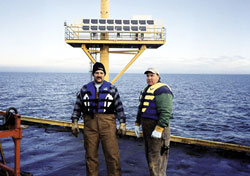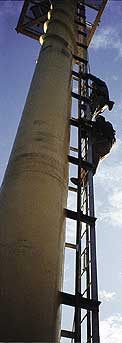
By Land or By Sea
|
 |
IBEW members Dave Vaso, left, (Local 24) and Cal Parker (Local 70) at work on the U.S. Coast Guard Tolchester Channel Project. Behind them are the solar panels set on light stands on the Chesapeake Bay. The contractor on the project was Enterprise Electric. |
Members of Local 70, Washington, D.C., and Local 24, Baltimore, Maryland, performed all of the electrical work on the project to install Coast Guard-provided navigational equipment on the Tolchester Channel front and rear "ranges," which utilize lights to provide direction to barges and vessels. Frequent bad weather and a treacherous course make Tolchester Channel a navigational challenge for ship pilots. The new signal ranges will make the course easier to maneuver.
The channel is located on the Eastern shore of the Chesapeake Bay in Maryland and Virginia. The project was begun on Labor Day 2001 and completed by Thanksgiving.
"It is quite a challenge to make conduit changes in direction and conduit terminations while fighting the currents and the elements on the Chesapeake Bay in November," said Local 70 Business Manager James W. Spruill.
Two battery banks supply electrical power for each of the ranges, and the batteries are charged by a solar photovoltaic system comprising fifteen 35-watt solar array panels, said Local 70 member Cal Parker, who worked on the project. "The 200-pound battery cells were extremely fragile and expensive, requiring two workers to carefully lift them into place."
Parker said the IBEW team did as much of the work as possible on the ranges while they were dry-docked. "After all of the optic and solar mounting stands were mounted on the ranges in Tolchester Channel, it was then necessary for us to complete our conduit, cabling and termination on site in the channel," Parker said.
"Once completed, the IBEW crew placed the equipment in operation and tested it in the presence of the U.S. Coast Guard," said Local 24 Business Manager James B. Kauffman. "The two-hour test was successful as was the 24-hour function test."
Continuous DC power feeds two Coast Guard night-time obstruction lights and the range switch box, said L.U. 70 Press Secretary Jerry Deinlein. "The switch box contains a photo-electrically controlled relay switch that enables daytime navigational lights and a night-time range light. The range lights were equipped with directional lamp-heads, and the obstruction lights were omni-directional. All conductors between the equipment were run in PVC coated rigid steel conduit, and each circuit required a separate conduit system."
![]()
